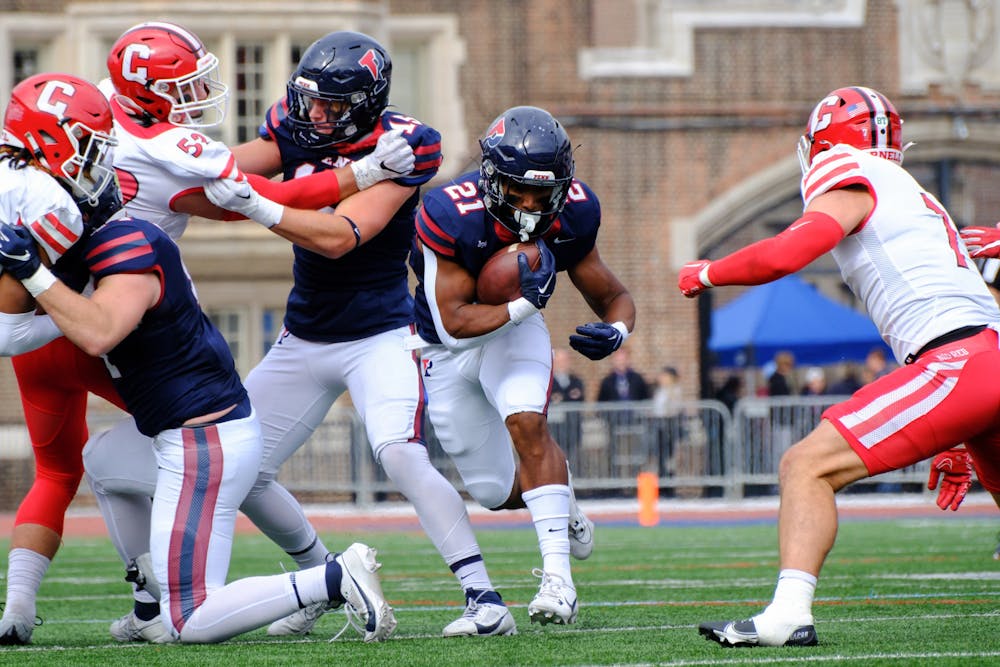
Senior running back Jonathon Mulatu moves the ball past Cornell's defensive line during the Homecoming game on Nov. 4.
Credit: Abhiram JuvvadiBefore I do anything else, I'd like to address the question posed in the title of this column. I'm aware that a team doesn't look the exact same every week. There are injuries — both the ones that keep players out of games and the ones that are played through — which are regularly sustained and recovered from in a sport as physical as football. There are fluctuations in game plans that come with different opponents, that require different players and aspects of the team to step up.
So yes, I am aware that Penn football cannot play the exact same game of football for 10 straight weeks.
But there are certain themes that cross between games that could have many different final scores. These include a swift offense, a stout defense, and an overall superior performance. Its those things that Penn could be doing every week, but what they haven't shown as consistently as they may need to.
Saturday's game against Cornell was unlike several of the other games the Quakers have played this year, and that's especially clear when discussing the offense, which seemed balanced above anything else. Junior quarterback Aidan Sayin only threw the ball 13 times, but when he did he looked poised and in command of the offense. Not only is this his fewest of the season but the next lowest is 35. Last week against Brown, Sayin attempted 55 passes.
According to coach Ray Priore, having Sayin throw fewer passes was an intentional part of the game plan heading into Saturday. Particularly, offensive coordinator Dan Swanstrom's plan involved limiting the number of screens and other quick passes that have been a signature part of the offense this year.
In their place is an increased emphasis on the running game, particularly freshman running back Malachi Hosley. After seeing his carry share steadily increase throughout the season, Hosley exploded Saturday, running for 261 yards, the third most in Penn history.
What will catch the headlines are his two long touchdown runs — of 68 and 96 yards — but beyond that, Hosley has still rounded into form as a great running back. If you remove those two carries, he had 19 carries for 97 yards, enough for an amazing 5.1 yards per carry average.
And now, when Sayin does throw the ball, things just feel smoother. Defenses play up to protect against the run, giving receivers more separation and play action has to be respected more. Sayin can allow routes to develop, rather than getting the ball to the outside and hoping for a receiver to break tackles. And the offensive line looks better in pass protection as they go up against wary and tired defensive fronts.
Penn's defense is also important to look at as well. Even though the Big Red got plenty of yards and dominated time of possession, the Quakers came up huge when things mattered most, especially on a goal-line stand in the second half to keep the contest a two-score affair.
And things could be looking up. Senior defensive back Jaden Key recorded a leaping interception in the fourth quarter during his limited snaps as he continues working his way back from an upper-body injury. He could provide a talented anchor to the back side of the Quakers' defense in the final two games.
Saturday's game was an amazing experience. A fun crowd at Franklin Field, perfect football weather, plenty of explosive plays, and — at the end of the afternoon — a win for Penn. While there may be some element of luck apparent in whether a run goes for 26 yards or 96, there are plenty of replicable elements of this win that can carry over to future games.
With two games left, this is when the rubber hits the road for the Quakers. They've shown that the potential is there multiple times, but they've also shown that they can sometimes fall short of this potential. So, all that's left to know is which Penn is going to show up against Harvard and Princeton.
CALEB CRAIN is a junior and current sports editor studying European history and statistics from Los Angeles. All comments should be directed to dpsports@thedp.com.
The Daily Pennsylvanian is an independent, student-run newspaper. Please consider making a donation to support the coverage that shapes the University. Your generosity ensures a future of strong journalism at Penn.
Donate







